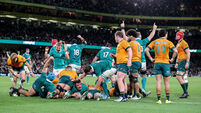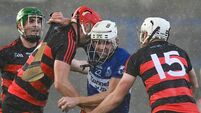Cathal Dennehy: Balancing quick wins with the search for future champs

BALANCING ACT: Shanbally's S Anna O'Neill shoots from Scoil Bride Crosshaven's Lucy K Murphy during the Allianz Sciath na Scoil Urban GFI final at SuperValu Páirc Uí Chaoimh. Picture: Eddie O'Hare
Picture this: You’re the coach of a decent underage team, maybe a Kennedy Cup side in soccer, a Junior Cup side in schools’ rugby or a promising U-14 outfit in Gaelic Games. The big event of the year is coming up and you’ve got a pool of 20-odd players from which to choose.
Who do you select? But more importantly: Why?
Are you thinking about where these kids might end up in five years and how a run-out here might benefit them? Or about who’ll get the job done here and now? That question, that conflict, captures a fundamental issue in youth sport: What is a coach’s role? To get results now or develop long-term potential? Because to achieve one, the other sometimes has to be sacrificed.
Granted, a short-term approach is often not harmful to long-term interests. But sometimes it is, specifically for late developers, kids who are dwarfed – and often flattened – by faster-maturing peers. For those picking teams there’s an inevitable bias at play: the top-performing players at, say, 14, are often those who’ve hit a growth spurt early – their height, strength or speed advantage meaning they’re often tagged as big talents.
Then there’s the relative age effect, a bias seen consistently in academies and underage international teams, with those born earlier in the year more likely to get opportunities than peers born later. One study sampling almost 3,000 high-level soccer players in Belgium found those born in the first quarter of the year were significantly over-represented relative to those born in the last.
A British study looking at professional clubs’ academies across 12 years found three times more players born in the first quarter than the last though, notably, more players from the last quarter went on to earn professional contracts, suggesting things even out over time.
But at underage, the faster, taller, stronger kids are more likely to get picked; as a result they’re more likely to end up in an academy, with all the opportunities that confers.
But how to account for such bias in coaching? That’s a topic Fionn Fitzgerald has spent significant time studying. Next weekend the All-Ireland-winning Kerry defender will line out for Dr Crokes in the Munster club final but he’s also knee-deep in his PhD at the University of Limerick, studying growth and maturation in young Gaelic footballers. Part of that involved looking at the Kerry and Cork Gaelic football academies and the biological maturation among their U-14, U-15 and U-16 players.
Boys typically have growth spurts from 13-14, a couple of years after girls, but the timing differs greatly. “Some have it at 11, others at 16,” says Fitzgerald, who has lived experience in this realm. “I’d have been a late maturer and found at 12, 13, 14, my game was based around skill, movement, agility, using my head, but at 18, 19, 20, it was a lot easier to mark guys I’d have struggled with when I was younger. I’d developed and they’d plateaued.”
By collecting players’ heights and weights and the heights of their parents, Fitzgerald could grade players on their maturation. He cites two 14-year-old teammates: one had reached 99% of his predicted adult height while the other was 25kg lighter, significantly smaller, and at 89% of his. There was a month between them in age but, biologically, it was about three and a half years’ difference. Both had the same predicted height as adults. But would both receive the same opportunities?
The traditional approach in sport is to categorise players by age, but talent development systems are fast catching on to bio-banding: grouping players based on physical maturation, ensuring they’ve an appropriate cluster of peers to train and compete against to optimise their development. It’s part of the much-heralded approach taken in youth soccer in Belgium.
Fitzgerald says about 15% of youngsters mature early, 15% mature late and the rest are “on time”. But in his work in the Cork and Kerry academies, he found just one late developer among 247 players. “There’s basically no late maturing in the system,” he says. “It’s similar in a number of sports; it’s the same in the Premier League academies.”
In another study, Fitzgerald looked at coaches’ ability to detect early/late developers and found there was huge variation – and little accuracy – in their assessments. That lack of awareness can have a significant impact on the path a player takes.
“The boys who go through their growth spurt earlier, they have a huge advantage and the coaches tend to pick the players who are performing best at that time. In athletics, it’s the fastest, most powerful (kid), but in Gaelic football or rugby it’s the ones who command the central positions and the early maturers who get all the breaks.”
But there’s also a flip side, with early developers often shortchanged on technical and tactical coaching, given how easy it all might come for them. There’s also a risk with growth spurts: injury rates are higher, coordination can be lower and performance can often initially regress.
“I say to parents or coaches: ‘Some of these players are going from driving a Micra to driving a Ferrari in six months,’” says Fitzgerald. “We found players who put on 10-12kg in a year so imagine trying to run around with that new body. If coaches think they’re underperforming or not moving as well, it’s not a big surprise.”
This is where it pays to take the long-term view, but such patience is often at odds with the reality of coaching when players, parents, administrators and often coaches themselves simply want results.
In the search for future champions, the first metric most scouts look for is performance, but it’s fiendishly difficult to tell who will develop into top seniors. “Trying to keep the net wide and give everyone a chance as long as possible is definitely the best way,” says Fitzgerald, who has given presentations to many underage coaches and always finds them receptive, keen to apply best practices. What advice does he give?
“The first one would be to monitor growth,” he says, suggesting coaches track height and weight twice a year to understand the rates at which different players are maturing. “Even if you don’t do that, it’s to keep a more open-minded or long-term view because everyone develops at their own rate and what you see at underage is generally not a good measure for where they’ll end up as an adult.”
But how to balance inclusion and long-term development for all with the obvious desire to win?
“You nailed the biggest obstacle – the winning mentality of coaches,” says Fitzgerald. “When it comes down to picking squads or teams for big events, it still seems to be that in general, people revert to type, picking the dominant players at this period who are performing better. That’s across all sports. It’s not that winning is a bad thing. From a coach’s point of view, winning is great and it’s important younger people get a feel for that, but it’s (crucial) coaches are keeping a longer-term view.”
Because if given sufficient time and the right environment, the biggest talents will usually rise to the top as seniors – where it matters most. But many late bloomers might be getting lost along the way.











